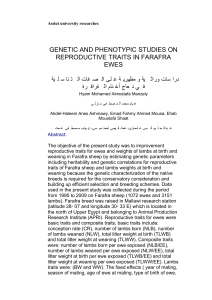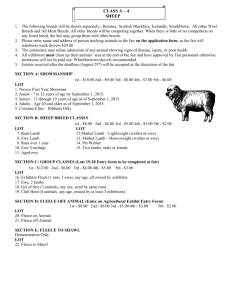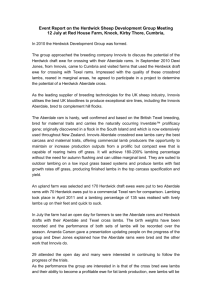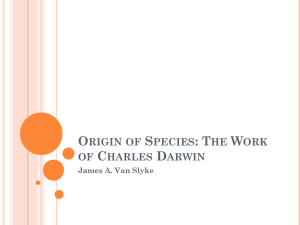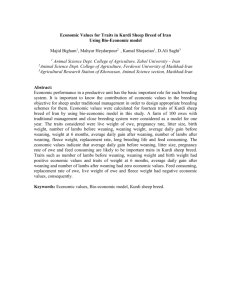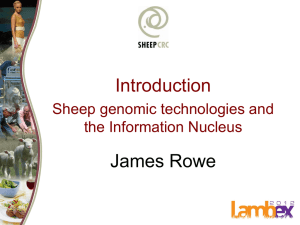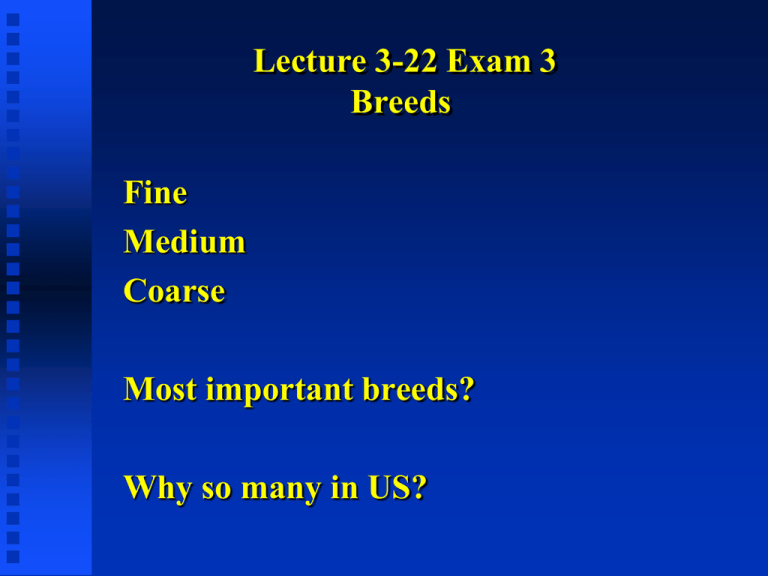
Lecture 3-22 Exam 3
Breeds
Fine
Medium
Coarse
Most important breeds?
Why so many in US?
Performance Records
Purebred Operations:
More records required
Registration work
Traits important to breed
Genetic Improvement:
3 factors
1. Selection differential
2. Heritability
3. Generation interval
Selection Differential
SD is the superiority of replacements
compared to flock average.
Example: Average adjusted WW 60
Replacement Ewes - 70
70 - 60 = 10 x .5 x .2
SD = 1.0
Replacement Ram = 85 pound adj. ww
85 - 60 = 25 x .5 x .2
SD = 2.5
Total SD = 2.5 + 1.0 = 3.5
Limits to Selection Differential
Sires provide more improvement
SD with only one trait
More traits - SD per trait decreases
Heritability
% of what you see which is due to
genetics.
Traits
Reproduction
Growth
Carcass
Wool
h2
.1 - .2
.25 - .40
.3 - .5
.4 - .6
Low h2 traits require multiple records
Example: Lambs born
h2 - .10 with r < .20
Repeatability - likelihood that a ewe
twinning in 2011 will twin in 2012.
Lamb crop in U.S. has not increased.
Number born increases with ewe age
Selection based on one record must
account for fixed effects.
Ex: 5 year old ewe with twins in
2011
Individual record not important.
Perspective buyers
What has she done relative to flock
average each of past five years
Wool traits
highly heritable
highly repeatable
one record of performance
Generation Interval
How fast the flock turns over.
GI = Average Ewe + Average Ram Age
2
4 + 2 = 3.0
2
GI - Smallest possible = 1
Economic suicide
Why ??
Best Solution = let ewe age float
Rams use only one year
Use older rams from other flocks
Economic Traits
Ewes:
Pounds Weaned
Mothering ability
Milking ability
Prolificacy
Growth
Hardiness and Longevity
Extended Breeding Season
Clean Wool
Economic Traits
Rams:
Offspring Vigor and Livability
Rate of Gain
Feed Efficiency
Breeding Capacity
Carcass Cutability
Lambing Ease
Genetic Improvement
Set Selection Goals
Identify Superior Individuals
NSIP
- uses all performance records
- fair comparisons via
contemporary groups
- provides genetic estimates on
animals without records
ex. rams and young lambs
Maternal
Growth
Wool
NSIP Traits
Lambs born
Pounds Weaned
Maternal Milk
60, 120, 365
Grease Fleece Weight (GFW)
Fleece Length
Fleece Grade
Fixed Effects
Adjust for:
Dam Age
Type of Birth and Rearing
Age Adjustment
Sex
Contemporary groups
What is it?
When are they needed?
Other Sheep Improvement Plans
Lamb Plan
Wool Plan
Ewe Byte
Group Breeding Schemes
Great
Britain
SUFFOLK SIRE REFERENCE SCHEME
Canada
Western Suffolk Sire Reference program
Ontario Suffolk Sire Refernece program
Why is group breeding successful.
Why does sheep industry not embrace
genetic improvement?
Purebred breeders
Commercial producers


